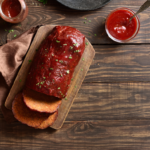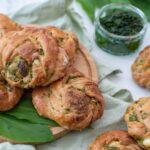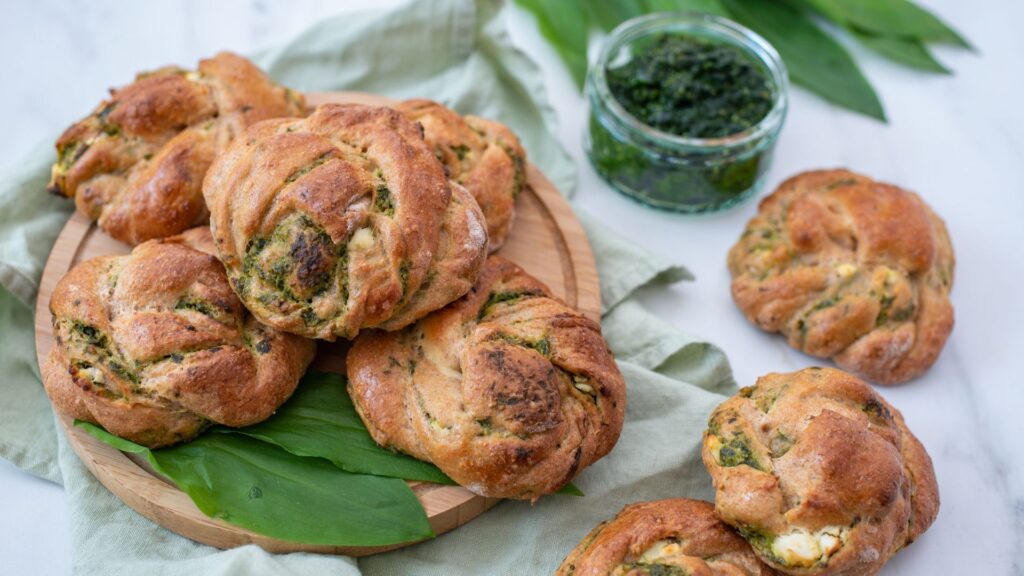
Imbloc, A Celtic Tradition: The Period Between Winter Solstice and Spring’s Beginning
Did you know that cheesy onion biscuits with a big smear of butter are associated with gratefulness and optimism? It’s one of several dishes historically found at meals that celebrate February 1st—Imbolc or Astronomical Spring—and February 2nd, which has morphed into the modern Groundhog Day. Humans have enjoyed particular dishes to ritually and emotionally welcome the lengthening day for millennia. People understood they depended on seasonal food access and that even hunting was at the mercy of weather and animal behavior.
The etymology of Imbolc refers to “in the belly” since domestic animals are pregnant in winter and produce milk for the babies born in the spring. It may still be quite cold or snowy, but tendrils of green are climbing up from the soil.
Some communities stored domesticated animals and harvests for winter, while others relied primarily on foraging and hunting. By winter’s end, food was getting scarce. Imbolc marks the incrementally extended daylight that awakens wild garlic and onions—some of the first fresh plants to appear. People build fires, sharing revelry and gratitude for making it through winter with feasts. Grains, cheeses, butter, milk, and optimistic spring greens make up these meals. Even now, we enshrine these foods as symbols of early spring.

We can invite this festive and grateful energy into this century and our lives. What a cheerful way to interrupt the sometimes oppressive cold and gray winter days. In the 21st century, people are not as tightly bound to seasonal rotations or natural light cycles due to their connection to the grid and the global food industry. We entrench ourselves in the hustle of deadlines, the economy, careers, staying informed, grocery shopping, laundry, rush hour, crime statistics, and paying bills.
But we are also sensuous mammals, our senses enmeshed with light, temperature, scents, and sound changes. All of these stimuli trigger responses in our bodies and behavior. Our modernity abstracts how we entangle with nature, and trivializing its influence shrinks our impulse to be playful, contented and inspired. Consider an Imbolc-inspired meal with your family to root yourself back into rhythms and cycles. Or reach out to others and have a potluck feast with a gathering of people. You can share the Onion and Cheese biscuits and an excellent rich butter. The ingredients are probably already in your home or easily picked up at a market.
Science and folklore agree that it is good for our health to give some time and attention to our environment and share it with other living beings.
One way I’ve started to appreciate the living beings I interact with every day is to learn their names. I’ve begun discovering what wild plants are edible around me growing wild. I experiment with gardening but am more intimidated by it than Early Spring foraging. Early spring is a low-effort window for beginners like myself because there’s only a little green coloring in the soil. It’s much easier to discern one plant from another.
If you’d like to be bold and find a plentiful, unassuming plant to forage and use immediately, find field garlic (allium vineale) and field onions (Allium Canadense). They grow almost anywhere. In the Northern Hemisphere, they sometimes appear on winter days with some warm sunshine. In early spring, they come forth and are often mistaken for fast-growing grass.

Step one: Find a field or a yard. It could be your yard, a shared bit of grassy area in your apartment complex, landscaping at your place, a public park, or an edge of woods. Field onions and garlic grow anywhere in soil and sunlight.
Do take a moment to consider the “isolation” of your spot. I prefer a place away from dog walkers or heavy industry. There are varying opinions about pesticides/herbicides. Still, I won’t harvest where little lawn treatment flags protrude from the ground. Many public parks and woodlands are sprayed with treatments, too. I prefer to forage inside a forest rather than from its edges, where they mainly concentrate the spraying. Sometimes, there is signage after an application.
When you’ve picked your first spot, quickly scan and notice clumps growing taller than the surrounding grass. Please take a little pinch of stalk and smell it. If you smell either garlic or onion- bingo! You’ve found them. The garlic scent is so distinctive, while the onion is more subtle. Because they look so similar, the aroma will be your reliable identifier. Before the Spring Equinox, you are unlikely to have flowering, but you can see differences in their leaves. Field Garlic is a darker green, with hollow leaves like little straws. Field Onions are not hollow.
You can gather leaves by pulling them or cutting them with scissors to harvest.
The leaves are saturated with flavor, but if you want the little bulbs for extra punch, dig down around the plant with a tool like a spade or even a giant spoon. The bulbs will come out caked in soil, and you may not get all of them entirely, but that’s okay. The remaining bulbs will grow again. They are tenacious, and a lot of people consider them weeds.
Bring something along to carry your treasure. It could be a basket or a washable bag. It will get dirty and soak up that Allium scent. Please give them a good soak in hot water at home, which will loosen the soil. Rinse them a few times, and that’s all there is to it. The next delight is deciding how you’ll use your treasure. Making the cheese and onion biscuits with these may make you feel optimistic and accomplished.
Another bonus to discovering the wild plants we intermingle with daily is that many people already know what these plants look and taste like. There are field guides, websites, YouTube videos, local classes, and flesh-and-blood people who love to share their interests with you.
Recipe for Cheesy Onion Biscuits
- 2 cups all-purpose flour or gluten-free. (We like Cup4Cup)
- 1 tablespoon baking powder
- 1/2 teaspoon baking soda
- 1/2 teaspoon salt
- 1/2 cup cold unsalted butter, cut into small cubes
- 1 cup shredded cheddar cheese
- 1 small onion, finely chopped
- 1/2 cup buttermilk
- 1/4 cup sour cream
- 1 tablespoon honey (optional, for a touch of sweetness)
- 1 tablespoon chopped fresh parsley (optional, for garnish)
Instructions:
- Preheat your oven to 425°F (220°C). Line a baking sheet with parchment paper or lightly grease it.
- In a large mixing bowl, combine the flour, baking powder, baking soda, and salt.
- Add the cold butter cubes to the dry ingredients. Use a pastry cutter or your fingertips to rub the butter into the flour mixture until it resembles coarse crumbs.
- Stir in the shredded cheddar cheese and chopped onion until evenly distributed.
- In a separate small bowl, whisk together the buttermilk, sour cream, and honey (if using).
- Make a well in the center of the dry ingredients, and pour the buttermilk mixture into the well. Gently stir until the dough comes together. Be careful not to overmix.
- Turn the dough out onto a lightly floured surface. Pat it into a rectangle about 1/2 to 3/4 inch thick.
- Use a biscuit cutter or a sharp knife to cut the dough into biscuits. Place the biscuits on the prepared baking sheet, leaving a little space between each one.
- If desired, brush the tops of the biscuits with a little extra buttermilk or melted butter for added flavor and color.
- Bake in the preheated oven for 12-15 minutes, or until the biscuits are golden brown and cooked through.
- Remove from the oven and sprinkle with chopped fresh parsley, if using. Serve warm and enjoy your cheesy onion biscuits!







